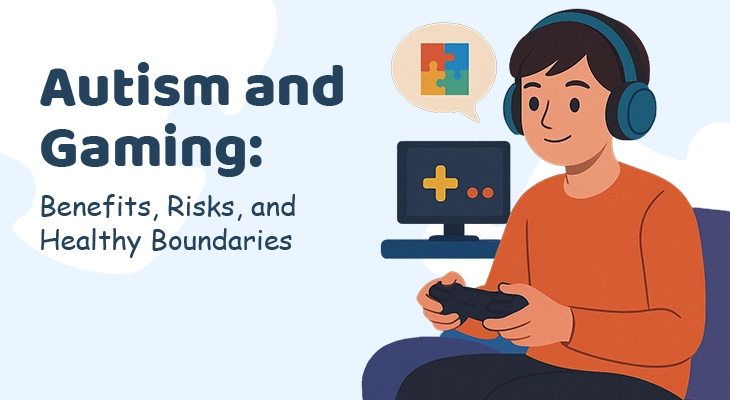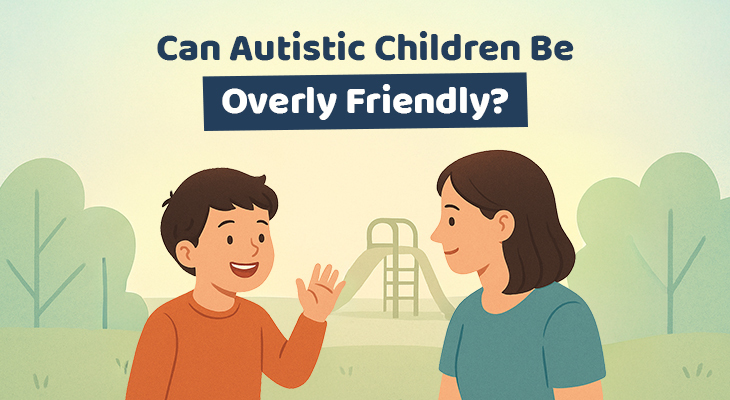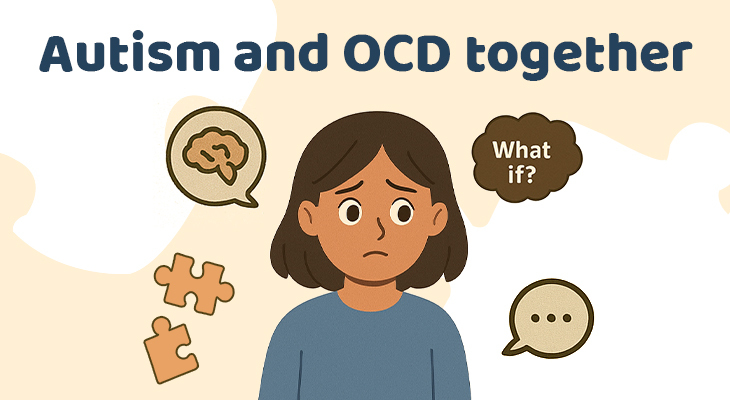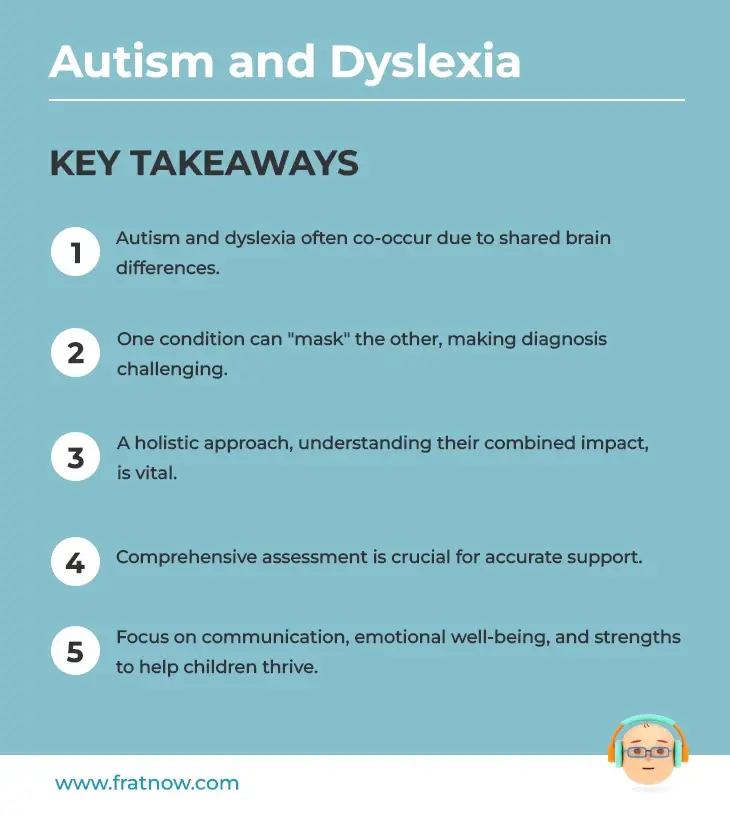
Download Download & share this Knowledge card in your network [Free Download]
Introduction
Imagine a child whose mind is buzzing with ideas and stories, yet who stares at words on a page as if they’re a jumbled, dancing mess, making reading a constant and frustrating struggle. Or picture another who deeply longs for connection, but finds the subtle, unwritten rules of social interaction utterly baffling, leading to quiet, isolated moments amidst bustling peers. Often, when such a child receives a diagnosis of autism or dyslexia, it brings a sense of relief and a clearer path forward. But what if that crucial answer, while true, is still incomplete, and another intertwined challenge lies just beneath the surface?
Autism and dyslexia are both distinct neurodevelopmental differences, meaning they affect how a person’s brain is wired. Individually, they present unique challenges and strengths. But what happens when these two conditions coexist? How do we best support children when their brains process information in unique, sometimes overlapping ways, making their path to learning and connecting even more complex? Let’s unravel these threads together.
The Statistical Reality: More Common Than You Think
It might seem like a coincidence if a child faces challenges with both social interaction and reading, but research tells a different story. The overlap between autism and dyslexia is, in fact, more common than many realize, pointing towards shared underlying neurobiological pathways.
Autistic Individuals and Dyslexia
Studies indicate a significant co-occurrence. While estimates can vary based on the specific diagnostic criteria and study populations, research frequently suggests that up to 50% of individuals diagnosed with Autism Spectrum Disorder also meet the diagnostic criteria for dyslexia [2]. Some studies even report higher figures in specific cohorts. This highlights that literacy difficulties are not uncommon within the autistic population.
Dyslexic Individuals and Autism
Conversely, a notable percentage of individuals primarily diagnosed with dyslexia also present with autistic traits or meet the criteria for Autism Spectrum Disorder. Current research often suggests this figure could range from approximately 5% to 15% of dyslexic individuals. This means that for a child struggling with reading, it’s always worth considering broader neurodevelopmental assessments.
Autism and Dyslexia: Shared Genetic Predispositions and Overlapping Brain Regions
The significant co-occurrence of autism and dyslexia isn’t merely a coincidence; it’s increasingly understood to stem from shared neurobiological foundations. This means that at a fundamental level, there are common genetic factors and overlapping brain mechanisms that can contribute to the development of both conditions.
Shared Genetic Blueprints of Autism and Dyslexia
- Polygenic Nature: Both autism and dyslexia are considered “polygenic,” meaning they are influenced by multiple genes, rather than a single gene.
- Common Candidate Genes: Intriguingly, some of these candidate genes are emerging as potential contributors to both conditions.
Overlapping Brain Regions and Networks in Autism and Dyslexia
- Language Processing Hubs: Both autism and dyslexia often involve differences in how the brain processes language. Neuroimaging studies have identified overlapping atypicalities in brain regions crucial for phonological processing (the ability to recognize and manipulate sounds in language), word recognition, and language comprehension.
- Connectivity Differences: In both autism and dyslexia, there can be atypical connectivity (e.g., reduced long-range connections or altered local connections) that impacts efficient information processing, particularly related to language.
- Executive Functions and Attention Networks: Both conditions can affect executive functions (like working memory, cognitive flexibility, and planning) and attention regulation. These areas are crucial not just for academic learning but also for navigating social environments.
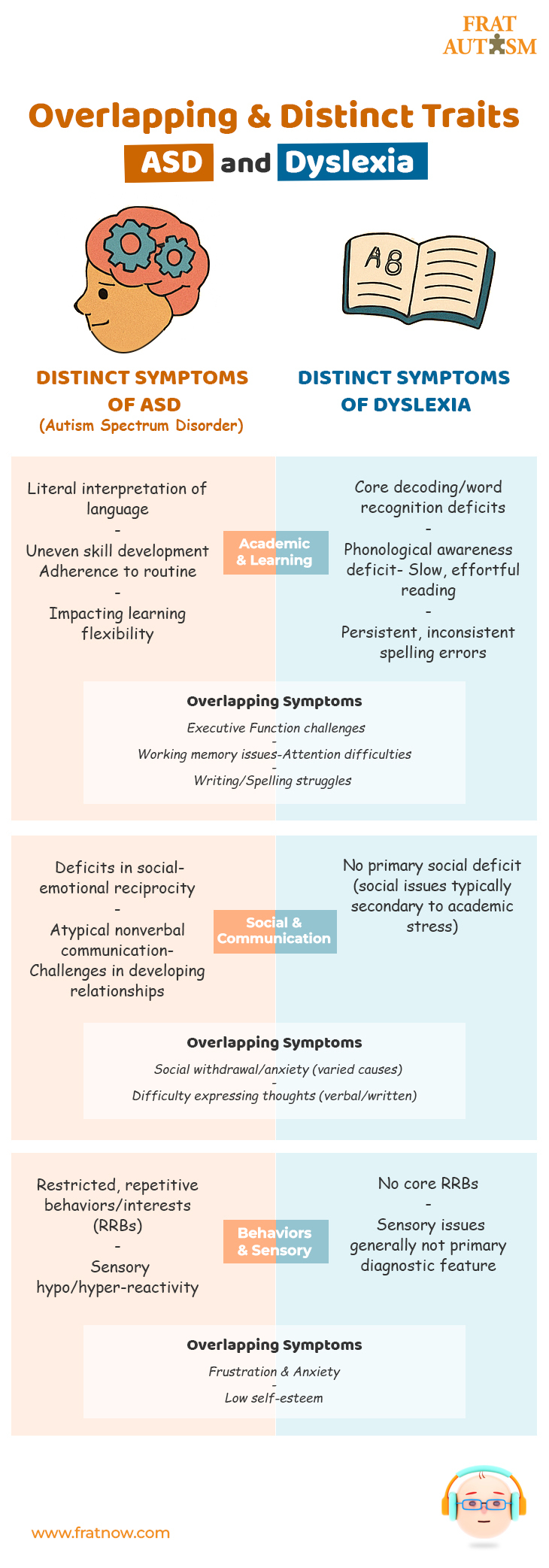
Download Download & share this infograph card in your network [Free Download]
The Masking Phenomenon: Hiding in Plain Sight
When autism and dyslexia co-occur, they can often play a tricky game of “masking”. This means that the more prominent or recognized symptoms of one condition might unintentionally obscure or hide the signs of the other, making it incredibly challenging for parents, educators, and even professionals to identify both. It’s like one puzzle piece is covering another, preventing a complete picture of a child’s unique profile.
How Dyslexia Can Mask Autism
Imagine a child, let’s call him Liam. Liam is clearly struggling with reading and writing; he mixes up letters, reads very slowly, and spelling is a constant battle. His teachers and parents understandably focus intensely on his academic struggles, providing extra phonics lessons and tutoring. During this time, Liam might also be a little quiet in class, prefer playing alone during breaks, or struggle to understand jokes or social nuances. These social and communication challenges, which could be signs of autism, might be attributed solely to the frustration and anxiety caused by his dyslexia. Adults might think, “He’s just withdrawn because reading is so hard for him,” overlooking the underlying autistic traits.
How Autism Can Mask Dyslexia
Now consider Sophia, a child who has received an autism diagnosis. Her communication differences, strong adherence to routines, and unique sensory sensitivities are well-recognized. When Sophia struggles with reading – perhaps reading very literally, having difficulty sounding out new words, or consistently misspelling – these academic challenges might simply be seen as part of her broader autism profile. There might be an assumption that her learning struggles are because of her autism, rather than recognizing them as a distinct learning disability like dyslexia. Additionally, autistic children might express their difficulties differently, and Sophia might not articulate her specific struggles with decoding words, further contributing to her dyslexia remaining undiagnosed.
The Cost of Hiding in Plain Sight
The consequence of this masking phenomenon is significant: delayed or completely missed diagnoses for one or both conditions. When only one piece of the puzzle is identified, the support provided is often incomplete or misdirected. This means children might not receive the specific, targeted interventions they need for all their challenges, impacting their academic progress, emotional well-being, and overall development. Recognizing this potential for masking is the first critical step toward ensuring comprehensive and timely support.
The Main Focus: A Holistic & Integrated Approach
When autism and dyslexia coexist, our goal isn’t to treat two separate diagnoses in isolation. It’s about understanding their combined impact on your child’s daily life and learning. This calls for a truly individualized support plan that sees the whole child, not just their labels. Here’s how to focus your efforts:
Action 1: Seek Comprehensive Assessment
If one condition is suspected, insist on evaluations that thoroughly screen for both autism and dyslexia. A complete picture leads to complete support.
Action 2: Prioritize Communication
Work with professionals to develop clear, effective communication strategies. This foundational skill impacts everything, from learning to social connections.
For example, for a child who struggles with both social interaction and written expression, this might mean using visual schedules and social stories to clarify expectations and transitions (benefiting autism). Simultaneously, employing text-to-speech software for reading and speech-to-text tools for writing assignments (benefiting dyslexia) can empower them to express their thoughts. It could also involve explicitly teaching pragmatic language skills or encouraging verbal explanations for concepts they struggle to put on paper.
Action 3: Nurture Emotional Well-being
Address anxiety, frustration, and self-esteem issues head-on. Teach emotional regulation strategies to help your child navigate challenges.
For example, a child might experience intense anxiety about reading aloud due to dyslexia, or overwhelming frustration when social cues are missed due to autism. Strategies can include teaching deep breathing exercises before a challenging task, creating a designated “calm-down corner” with sensory tools at home, or helping them identify emotions by using “feeling charts” or emotion thermometers. Openly discussing that their brain “just works differently” in these areas can also significantly boost self-esteem and reduce feelings of inadequacy.
Action 4: Build on Strengths
Identify and lean into your child’s unique talents and interests. Use their strengths as a pathway for learning, building confidence, and fostering engagement.
For example, many autistic children have intense special interests (e.g., dinosaurs, space, coding) or excel in visual thinking and pattern recognition. Children with dyslexia often show remarkable creativity, spatial reasoning, or problem-solving abilities. Use these! If your child loves dinosaurs, incorporate dinosaur-themed audiobooks, documentaries, or encourage drawing/building related to their interest. If they are visually strong, use diagrams, mind maps, or graphic organizers to teach reading comprehension or complex concepts. A passion for building with LEGOs can be a gateway to understanding engineering concepts, even if reading written instructions is challenging.

Download Download & share this infograph card in your network [Free Download]
Conclusion
Autism and dyslexia frequently co-occur, a complex interplay often rooted in shared brain differences. One condition can even “mask” the other, leading to missed diagnoses and incomplete support.
To truly help, a holistic, individualized approach is vital. Focus on comprehensive assessments, clear communication strategies, nurturing emotional well-being, and building on unique strengths.
Understanding these intertwined challenges empowers children to thrive. By seeing the whole child and providing tailored support, we unlock their full potential, ensuring a future where they feel understood and confident.
FRAT® Test - Key Facts To Know
Of the 20,000+ individuals tested with the FRAT® test, a significant percentage showed positive results, indicating the presence of Folate Receptor Autoantibodies. Supplementation with alternative treatments like folinic acid has demonstrated improvements in quality of life for many of these individuals.
A FRAT® user’s TikTok video, sharing her child’s positive transformation following a positive FRAT® test result, went viral. Since its posting, the video has garnered an impressive 800K views, 79K likes, 27K shares, 33K bookmarks, and over 3K comments. Watch the video below:
@kyra2532 LIFE CHANGING updates for children with autism. #autismmom #childwithautism #autismresearch #autismfamily ♬ original sound - Kyra
Note: This video is only available in
regions where TikTok is available.
Over the years, more than 1400 physicians have been prescribing the FRAT® Test, underscoring its growing recognition as a valuable diagnostic tool.
Here’s what Maxwell (Parent to an autistic child) has to say about the FRAT® test:

MAXWELL M.
References
- NIH, Dyslexia: neurobiology, clinical features, evaluation and management
- Apex ABA Therapy | Autism and Dyslexia: The Link Between
- NIH, Autism and Dyslexia
- Autism Speaks, Autism and dyslexia
- Autism Parenting Magazine, Dyslexia and Autism: Is there a Connection?
- Cross River Therapy, Autism and Dyslexia: Similarities & Differences

